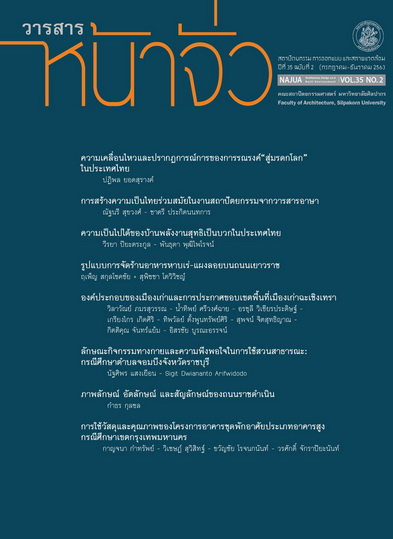ลักษณะกิจกรรมทางกายและความพึงพอใจในการใช้สวนสาธารณะ: กรณีศึกษาตำบลจอมบึง จังหวัดราชบุรี
คำสำคัญ:
กิจกรรมทางกาย, ความพึงพอใจ, สวนสาธารณะ, จอมบึงบทคัดย่อ
การวิจัยครั้งนี้มีวัตถุประสงค์เพื่อศึกษาลักษณะกิจกรรมทางกายในสวนสาธารณะ รวมถึงทัศนคติ ความพึงพอใจ และประโยชน์ที่ผู้ใช้บริการได้รับจากการใช้สวนสาธารณะในตำบลจอมบึง เพื่อนำไปสู่ข้อควรพิจารณาในการเสนอแนะถึงแนวทางการปรับปรุงพื้นที่สวนสาธารณะเพื่อส่งเสริมกิจกรรมทางกายต่อไปโดยมีกรณีศึกษา 2 แห่ง ได้แก่ สวนสาธารณะบึงจอมบึงและสวนสุขภาพราชพฤกษ์ โดยใช้การสำรวจและเก็บข้อมูล 2 รูปแบบ ดังนี้ 1) System for Observing Play and Recreation in Communities (SOPARC) เป็นเครื่องมือสำรวจและสังเกตการณ์โดยตรงอย่างเป็นระบบเพื่อประเมินการใช้สวนสาธารณะและพื้นที่นันทนาการ และ 2) การใช้แบบสอบถามในการประเมินพื้นที่ จากการสำรวจความคิดเห็น และทัศนคติของผู้ใช้สวนฯที่มีต่อสภาพแวดล้อม ประกอบด้วย การใช้ประโยชน์พื้นที่ ความปลอดภัย กิจกรรม ความสวยงาม ความสะอาด การเดินทาง และสิ่งอำนวยความสะดวก ซึ่งผลการวิจัย พบว่า ลักษณะกิจกรรมทางกายในสวนสาธารณะในตำบลจอมบึง พบกิจกรรมทางกายระดับเบามากที่สุด รองลงมา คือ กิจกรรมทางกายระดับปานกลางถึงหนัก และที่น้อยที่สุด คือ กิจกรรมเนือยนิ่ง และพบผู้ใช้บริการสวนสาธารณะที่เป็นกลุ่มช่วงวัยเด็กจำนวนน้อยมากจนถึงไม่มี ทั้งนี้ผู้ใช้บริการสวนสาธารณะมีทัศนคติด้านประโยชน์ที่ได้รับจากการใช้สวนสาธารณะ คือ ช่วยให้มีอารมณ์และสุขภาพจิตที่ดีขึ้นเป็นสัดส่วนที่มากที่สุด และผลเฉลี่ยค่าความพึงพอใจของภาพรวมสวนสุขภาพราชพฤกษ์อยู่ในระดับพึงพอใจมากที่สุดและสวนสาธารณะบึงจอมบึงอยู่ในระดับพึงพอใจมาก การศึกษาครั้งนี้ สรุปข้อควรพิจารณาเพื่อนำไปสู่การเสนอแนะถึงแนวทางการปรับปรุงพื้นที่สวนสาธารณะเพื่อส่งเสริมกิจกรรมทางกายต่อไป ได้ดังนี้ การจัดเตรียมพื้นที่สำหรับกิจกรรมทางกายที่เหมาะสมกับทุกกลุ่มช่วงวัย ซึ่งควรมีพื้นที่ให้ครบทุกระดับของกิจกรรมทางกาย โดยเฉพาะกิจกรรมทางกายระดับปานกลางและหนักอาจต้องมีความหลากหลาย เพื่อส่งเสริมการทำกิจกรรมทางกายแก่ผู้ใช้บริการสวนสาธารณะทุกเพศ ทุกวัย โดยมีข้อเสนอแนะในการวิจัยครั้งต่อไป ให้มีการใช้เครื่องมือการสำรวจ SOPARC ประกอบกับแบบสอบถามเพื่อสำรวจความคิดเห็นและแรงจูงใจของผู้ใช้สวนสาธารณะที่หลากหลายกลุ่มและมีความเฉพาะเจาะจงมากยิ่งขึ้น รวมถึงการจัดการสนทนากลุ่ม การสัมภาษณ์ผู้มีส่วนได้ส่วนเสียเพิ่มเติม เพื่อนำไปประยุกต์ใช้ในแนวทางการปรับปรุงสวนสาธารณะที่ก่อให้เกิดสิ่งแวดล้อมสรรสร้างที่สามารถปรับปรุงคุณภาพชีวิตให้เป็นพื้นที่สุขภาวะที่ดียิ่งขึ้นไป
เอกสารอ้างอิง
- Bedimo-Rung, A. L., Mowen, A. J., & Cohen, D. A. (2005). “The significance of parks to physical activity and public health: a conceptual model”. American journal of preventive medicine, 28(2), 159-168.
- Best, JW. (1977). Research in Education. New Jersey: Prentice Hall, Inc.
- Brownson, R. C., Hoehner, C. M., Day, K., Forsyth, A., & Sallis, J. F. (2009). “Measuring the built environment for physical activity: state of the science”. Am J Prev Med, 36(4 Suppl), S99-123.e112. doi:10.1016/j.amepre.2009.01.005
- Chandrasiri, O., & Arifwidodo, S. D. (2015). Botbat lae kan phatthana phuenthi suan satharana suan lum phi ni krungthepmahanakhon. (In Thai [Characteristic of District Park Use for Physical Activity Promotion: Case study of Benjakitti Park, Bangkok, Thailand]. Retrieved June 29, 2021, from http://padatabase.net/uploads/files/01/doc/506_NCPA2015_p565-575.pdf
- Chandrasir, O., & Arifwidodo, S. (2017). “Inequality in Active Public Park: A Case Study of Benjakitti Park in Bangkok, Thailand”. Procedia Engineering, 198, 193-199. doi:https://doi.org/10.1016/j.proeng.2017.07.083
- Cohen, D. A., et al. (2006). “Public parks and physical activity among adolescent girls”. Pediatrics, 118(5), e1381-1389. doi:10.1542/peds.2006-1226
- Ding Ding, & Klaus Gebel. (2012). “Built environment, physical activity, and obesity: What have we learned from reviewing the literature?”. Health & Place, 18(1), 100-105. doi: doi.org/10.1016/j.healthplace.2011.08.021.
- Google Earth. (2018). Tambon Chombueng. Retrieved July 27, 2021, from https://earth.google.com/earth/d/1oY0kc6INfxRg_Vdnl-j0gYP4enR7SXq_?usp=sharing
- Kaisornrat, S. (2016). “Naeothang kan phatthana kan thongthiao duai chakkrayan bon than sapphayakon thongthin chumchon Chom bueng changwat Ratchaburi”. (In Thai) “[Guidelines for Development of Using Bicycle Tourism Based on Local Resources Availability in Ratchaburi]”.In Rai-ngan suep nueangchak kan prachum wichakan radap chat ratchaphat muban chom bueng wichai khrang thi 4 pi 2559 [Proceedings of the 4th Muban Chombueng Rajabhat University’s Nation Conference 2016], 1458-1467.
- Klongvessa, N. (2001). Kan wangphaen lae okbaep suan satharana lae phuenthi nanthanakan. (In Thai) [Public Park and Recreation Area Planning and Design]. Bangkok: Chulalongkorn University Printing House.
- Kostrzewska, M. (2017). “Activating Public Space: How to Promote Physical Activity in Urban Environment”. IOP Conference Series: Materials Science and Engineering, 245, 052074. doi:10.1088/1757-899x/245/5/052074
- Lindberg, M., & Schipperijn, J. (2015). “Active use of urban park facilities – Expectations versus reality”. Urban Forestry & Urban Greening, 14(4), 909-918. doi:https://doi.org/10.1016/j.ufug.2015.08.007
- Luecha, T., & Bunluea, T. (2013). “Phuenthi nanthanakan thi mosom khong nisit thiyu asai nai phuenthi doi rop mahawitthayalai maha sarakham khet
phuenthi kham riang. (In Thai) [Recreation Areas for Collegiate Student in The Vicinity of Mahasarakham University (Khamriang Campus)]”. Warasan kanmueang kan pokkhrong. [Journal of Politics and Governance], 3(2), 160-175.
- Mutdeth, A., et al. (2018). “Sakkayaphap thang nanthanakan khong suan satharana nai khet krungthepmahanakhon. (In Thai) [The Recreational Potential of Public Parks in Bangkok]”. Warasan wichakan mahawitthayalai ratchaphat Phuket. [Phuket Rajabhat University Academic Journal], 14(2), 1-19.
- National Recreation and Park Association. (n.d.). Creating Safe Park Environ ments to Enhance Community Wellness. Retrieved October 5, 2021, from https://www.nrpa.org/contentassets/f768428a39aa4035ae55b2aaff372617/park-safety.pdf
- Physical Activity and Health, Division Department of Health. (2014). Khumue ken mattrathan suan satharana phuea kan okkamlangkai. (in Thai) [Active Public Park Standard Manual]. Bangkok: ACFT, Ltd.
- Sompong, C., & Khongouan, W. (2015). “Botbat lae kan phatthana phuenthi suan satharana suan lum phi ni krungthepmahanakhon. (In Thai) [The Role of Lumpini Park, Bangkok, and Its Developing Plan]”. Warasan Wichakan Khana Sathapattayakamsat Socholo. [Journal of the Faculty of Architecture King Mongkut’s Institute of Technology Ladkrabang], 12(1), 56-69.
- Songthummin, N., et al. (2010). “Kwam khithen to kan phatthana suan satharana thung simueang khong prachachon nai khet thetsaban nakhon Udon Thani. (In Thai) [Opinions of People in Udonthani Municipality Towards the Development of Tung Srimuang Public Park]”. Sak Thong: Warasan manutsat lae sangkhomsat mahawitthayalai ratchaphat kamphaeng phet. [The Golden Teak: Humanity and Social Science Journal], 16(1), 103-117.
- Tangkijngamwong, O., et al. (2015). Kan sangket pharuetikam phuchai suan satharana phuea pramoen radap kitchakam thang kai lae khwam samphan khong phuenthi kitchakam thang kai kap laksana thang kaiyaphap khong suan luang rachini (19 rai) amphoe hua hin changwat prachuap khiri khan. (In Thai) [Identifying Park-Related Physical Activity and Its Association with Physical Environment: A Case Study of Queen’s Park (19 Rai) Hua Hin, Prachuap Khiri Khan Province]. Retrieved June 15, 2021, from http://padatabase.net/uploads/files/01/doc/503_NCPA2015_p489-507.pdf
- Veitch, J., et al. (2014). “A natural experiment to examine the impact of park renewal on park-use and park-based physical activity in a disadvantaged neighbourhood: The REVAMP study methods”. BMC public health, 14, 600. doi:10.1186/1471-2458-14-600
- Weluwanarak, S., & Bejrananda, M. (2019). “Kansueksa pharuetikam kan chai phuenthi satharana nai khet mueang khong phu sung-ayu korani sueksa khet thetsaban nakhon Khon kaen. (In Thai) [The Study of Elderly Behavior in Urban Public Space Using Case Study Khonkaen Municipal Area]”. In Rai-ngan Kan Prachum Wichakan Sanoe Phonngan Wichai Radap Bandit Sueksa Haeng Chat Khrang Thi 20 [Proceedings of the 20th National Graduate Research Conference], 1550-1560.





